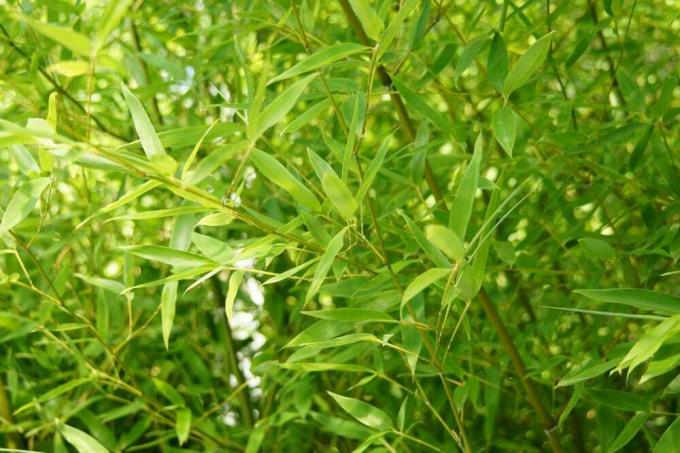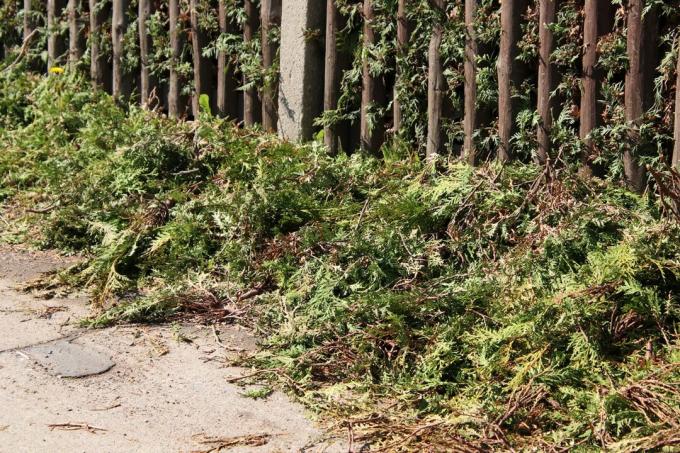

Table of contents
- bamboo
- Fargesia
- Phyllostachys
- pseudosasa
- Canadian hemlock
- Kapuka
- medlar
- sac flower "Victoria"
- spruces
- Aztec Pearl Orange Flower
Plants such as cherry laurel, thuja or boxwood are popular hedge plants in this country. For households with small children, however, they have a disadvantage: they are poisonous. If you are looking for non-toxic hedge plants that are also evergreen and fast-growing, you will soon realize that solving this task is not as easy as you think. Still, you don't have to despair, because these plants exist.
bamboo
Bamboo is a subfamily of the sweet grasses (Poacae). Within the subfamily there are approximately 116 genera. The fast-growing, evergreen species include the genera with the species:
Fargesia
The Fargesia bamboo genus includes around 90 species. The individual varieties do not form offshoots. Another feature is that these bamboos die after flowering. But don't worry, they only bloom every 80 to 100 years.
Fargesia murielae (garden bamboo)
- Varieties: "Jumbo", "Simba", "Superjumbo", "Standing Stone", "Emerald", "Maasai"
- Location: sun to shade (depending on variety)
- Soil: varietal dependent
- Height of growth: 200 to 350 centimeters (depending on the variety)
- Growth width: 75 to 250 centimeters (depending on the variety)
- Growth rate: 20 to 50 centimeters per year (depending on the variety)
- Growth: bushy, overhanging, umbrella-shaped or upright (depending on the variety)
- Leaves: soft green to medium green (depending on the variety), oblong, lanceolate, pointed (depending on the variety)
- Special features: very good winter hardiness
Fargesia nitida "Jiuzhaigo 1"
- botanical name: Fargesia nitida "Jiuzhaigo 1"
- Synonyms: Red Bamboo, Red Culm Bamboo
- Location: sun to shade
- Soil: rich in nutrients, permeable, no waterlogging
- Growth height: 300 to 400 centimeters
- Growth width: 250 to 400 centimeters
- Growth rate: 40 to 80 centimeters per year
- Growth: upright, dense, well branched
- Leaves: narrow, delicate
- Hardiness: minus 18 to 28 degrees Celsius
- Special features: 2005 "Bamboo of the Year", red culm sheaths
Umbrella Bamboo "Campbell"
- botanical name: Fargesia robusta "Campbell"
- Location: partial shade
- Soil: rich in humus, moist, sandy, well drained
- Growth height: 350 to 500 centimeters
- Growth width: 80 to 150 centimeters
- Growth rate: 20 to 45 centimeters per year
- Growth: upright, older plants overhanging
- Leaves: Dark green with a bluish underside, oblong
- Winter hardiness: down to minus 18 Celsius
- Special features: young shoots need protection from frost, light fragrance
umbrella bamboo
- botanical name: Fargesia rufa
- Synonyms: Sun-hard garden bamboo
- Location: sun to semi-shade
- Soil: rich in humus
- Growth height: 200 to 300 centimeters
- Growth width: 150 to 250 centimeters
- Growth rate: 40 to 50 centimeters per year
- Growth: upright to cascading, dense
- Leaves: oblong, intense green
- Hardiness: minus 24 degrees Celsius; protect from winter winds
- Special features: tolerates pruning very well, therefore ideal for low and medium-high hedges
Bamboo "Asian Wonder"
- botanical name: Fargesia scabrida "Asian Wonders"
- Location: sun to semi-shade
- Soil: normal garden soil, slightly acidic
- Growth height: 300 to 400 centimeters
- Growth width: 40 to 100 centimeters
- Growth rate: 10 to 50 centimeters per year
- Growth: upright, well branched
- Leaves: bluish green, lanceolate, shiny narrow
- Winter hardiness: down to minus 26 degrees Celsius
- Special features: purple stems, play of colours, robust, undemanding

Phyllostachys
In contrast to the Fargesia species, the representatives of this genus do not die after flowering. However, they form runners, so that a root barrier is absolutely necessary for some varieties.
Black Bamboo
- botanical name: Phyllostachys nigra
- Location: sun to semi-shade
- Soil: deep, permeable
- Growth height: 300 to 500 centimeters
- Growth width: 200 to 350 centimeters
- Growth rate: 20 to 50 centimeters per year
- Growth: loosely upright
- leaves: lanceolate, very thin (papery); Dark green above, grey-green below
- Hardiness: good hardy
- Root barrier: recommended
- Special features: black stems; forms comparatively few runners
pseudosasa
The genus Pseudosasa includes around 36 species. Since all representatives of this species form offshoots, a root barrier is recommended.
Japanese arrow bamboo
- botanical name: Pseudosasa japonicus, Arundinaria japonica
- Synonyms: Bambusa Metake, Medake Arundinaria
- Location: semi-shade to sun
- Soil: humic, permeable, also likes to be acidic
- Growth height: 300 to 500 centimeters
- Growth width: 100 to 200 centimeters
- Growth rate: 20 to 40 centimeters per year
- Growth: upright and overhanging
- leaves: large, green; yellow when sprouting
- Hardiness: minus 18 to minus 20 degrees Celsius
- Root barrier: necessary
- Special features: protect from cold easterly winds, sprout again after above-ground forest damage
Canadian hemlock

- botanical name: Tsuga canadensis
- Location: sun to semi-shade
- Soil: rich in nutrients, otherwise no further requirements
- Growth height: 1,500 to 2,000 centimeters
- Growth width: 600 to 1,200 centimeters
- Growth rate: 15 to 30 centimeters per year
- Growth: overhanging, umbrella-shaped or upright
- Leaves: green, needle-like
- Special features: frost hardy, tolerates pruning well
Tip:
The cushion hemlock, bot. Tsuga canadensis "Nana" is the small relative of the Canadian hemlock, but it grows only three to five centimeters per year.
Kapuka
- botanical name: Griselinia littoralis
- Synonym: New Zealand foliage leaf, Papauma
- Location: sun
- Soil: permeable, rich in nutrients
- Growth height: 150 to 500 centimeters (depending on the variety)
- Growth width: 75 to 250 centimeters (depending on the variety)
- Growth rate: 30 centimeters per year (depending on the variety)
- Growth: upright
- Leaves: green, glossy
- Flower: small, green-yellow
- Special features: only conditionally hardy (minus 5 to minus 10 degrees Celsius), wind-resistant, ideal for coastal regions
medlar
Photinus "Pink Crispy"
- botanical name: Photinia fraseri 'Pink Crispy'
- Location: sun to semi-shade
- Soil: permeable, fresh, moist, humic
- Growth height: 150 to 200 centimeters
- Growth width: 80 to 100 centimeters
- Growth rate: 15 to 20 centimeters per year
- Growth: bushy, upright, dense, well branched
- Flowers: medium-sized, simple, in panicles, red buds, white-pink flowers from April to May
- Leaves: green-white variegated
- Special features: hardy, pink leaf shoots

Red medlar "Red Robin"
- botanical name: Photinia fraseri "Red Robin"
- Location: sun to shade
- Soil: lime-free, warm, humic, loamy, profound
- Growth height: 150 to 300 centimeters
- Growth width: 120 to 200 centimeters
- Growth rate: 20 to 50 centimeters per year (depending on the variety)
- Growth: upright to broad bushy
- Flowers: medium-sized, white flowers from May to June
- Leaves: red when sprouting, later green
- Special features: conditionally hardy, fruits not suitable for consumption
sac flower "Victoria"
- botanical name: Ceanothus impressus 'Victoria'
- Location: sun to semi-shade
- Soil: normal garden soil
- Growth height: 80 to 100 centimeters
- Growth width: 50 to 70 centimeters
- Growth rate: 10 to 40 centimeters per year (depending on the variety)
- Growth: bushy, branched
- Flowers: small, deep blue, panicle-shaped flowers from the end of May to July
- Leaves: dark green, elliptic
- Special features: robust, hardy
spruces
Alcock's Spruce
- botanical name: Picea bicolor
- Location: sun to semi-shade
- Soil: well-drained, fresh to moist
- Growth height: 1,000 to 1,500 centimeters
- Growth width: 300 to 700 centimeters
- Growth rate: 10 to 30 centimeters per year
- Growth: upright narrow
- Leaves: bicolored needles, dark green above, blue-silver below,
- Special features: decorative cones
Blue spruce
- botanical name: Picea pungens var. glauca
- Synonym: blue spruce
- Location: sun
- Soil: no special requirements
- Growth height: 1,500 to 2,000 centimeters
- Growth width: 600 to 800 centimeters
- Growth rate: 15 to 30 centimeters per year
- Growth: upright, straight
- Leaves: Blue needles, two to three centimeters long
- Specials: can be used as a Christmas tree
Blue spruce "Blue Mountain"
- botanical name: Picea pungens
- Location: sun to semi-shade
- Soil: rich in nutrients, fresh, sandy, loamy
- Growth height: 1,500 to 2,000 centimeters
- Growth width: 600 to 800 centimeters
- Growth rate: 20 to 40 centimeters per year
- Growth: upright, conical crown
- Leaves: blue, prickly needles
- Special features: Cones only from the age of 30

Chinese spruce
- botanical name: Picea likiangensis var. rubescense
- Location: sun to semi-shade
- Soil: prefers moist, fresh, sandy soil, otherwise undemanding
- Growth height: 1,000 to 1,500 centimeters
- Growth width: 300 to 600 centimeters
- Growth rate: 10 to 30 centimeters per year
- Growth: upright, pyramidal, well branched
- Leaves: dark green-blue, short, pointed needles
- Special features: cone jewelry, decorative needles
Serbian spruce
- botanical name: Picea omorika
- Location: sun
- Soil: well drained, not compacted, soil tolerant
- Growth height: 1,500 to 3,000 centimeters
- Growth width: 250 to 400 centimeters
- Growth rate: 20 to 35 centimeters per year
- Growth: compact, dense, narrow
- Leaves: dark green, prickly needles; 8 to 18 millimeters long
- Special features: frost hardy, hanging cones, insensitive to diseases, easy to care for
Mourning hanging spruce "Inversa"
- botanical name: Picea abies 'Inversa'
- Location: sun to semi-shade
- Soil: sandy-loamy, fresh to moist
- Growth height: 600 to 800 centimeters
- Growth width: 200 to 250 centimeters
- Growth rate: 10 to 15 centimeters per year
- Growth: narrow, columnar
- leaves: needle-like, green
- Special features: good leaf health
Aztec Pearl Orange Flower

- botanical name: Choisya ternata 'Aztec Pearl'
- Location: sun to semi-shade
- Soil: permeable, acidic, rich in nutrients
- Growth height: 100 to 150 centimeters (depending on the variety)
- Growth width: 60 to 100 centimeters
- Growth rate: 10 to 20 centimeters per year
- Growth: compact, well branched
- Flowers: small, simple, pink buds; strongly scented, white flowers from May to June
- Leaves: medium green, long, narrow
- Special features: conditionally hardy, fragrant foliage, second flowering
 Home editorial office
Home editorial office
Learn more about hedges

Rocket juniper, Juniperus scopulorum: care tips
The rocket juniper (Juniperus scopulorum) is also known as columnar juniper and can reach impressive heights. Here we show how it can be cultivated successfully. There are also some care tips that can strengthen growth and the plant.

Conifers turn brown | reasons and solutions
Conifers are used in the garden as a hedge, group or solitary. Smaller specimens of the conifers decorate the balcony or terrace in the tub. If they turn brown, you should investigate the cause, because this behavior is usually not normal.

24 easy-care hedges – privacy without work
Hedges protect more or less well from prying eyes and are a good alternative to conventional fences. However, it is not always easy to find the right plants, especially when you want them to be as easy to care for as possible.

Pruning conifers: when is the best time?
Pruning conifers is easily possible with the right knowledge. But when is the best time for the measure and when is cutting allowed? Here is the most important information about cutting the coniferous hedge.

Fertilize thuja hedges: 7 effective fertilizers
Because of its dense growth, the Thuja is particularly valued as a hedge. In order for the growth to actually take place densely and without gaps, the plant needs sufficient nutrients. We explain how you should fertilize the tree of life for lush growth.

How fast do yews grow? | Yew hedge growth
The yew (bot. Taxus) is not without reason a popular garden and hedge plant, because it is an evergreen plant and can be easily cut into different shapes. Their growth depends on location and care.



